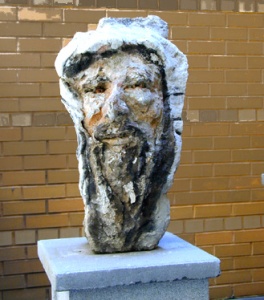What’s in a Name?
In Search of Ancestors, Sculpture by Simon Gaon
The name Simon Gaon I remember well. As a passionate painter and founding member of the rough and tumble “Street Painters” I knew him from many, many years ago when I was a participant and occasional program director of the Alliance of Figurative Artists. These meetings at the Educational Alliance, held from the early 1970s through the 1980s, presented a raucous forum for artists to battle beliefs and occasionally exchange ideas about Art and the turbulent art world of New York. As part of the “Alliance,” the Street Painters was a group dedicated to the primacy of the immediate visual experience of the streets of New York. They would paint their big expressionistic canvases standing on the sidewalks and streets, frequently in the midst of the crowds, to capture the vibrant life of the city’s streets; day or night, weather fair or foul. To them art was as much about personal encounters and experience as it was about aesthetics and ideas.


And now Simon Gaon has encountered something totally different. In the current exhibition of his cement sculpture at Yeshiva University Museum (until August, 2001), In Search of Ancestors, Gaon has embarked on a series of interior encounters. His own family name reverberates. His mother comes from Bukhara and his father was born in the old city of Jerusalem during Turkish rule and was part of the religious Zionist movement that built the Bukharan community in Jerusalem in the 19th century. Still, Gaon is pushing his encounters much further back in history; all the way to Rabbi Akiba, Bar Kochba and King David himself. These names leap out at us with a historical brilliance. He presents us with sixteen busts, mainly historical or allegorical heads. Included are also three “portraits” of friends and two self-portraits. Each bust is about twenty-four inches high and is executed in raw cement built up over natural stone. The effect is raw and expressionistic, with very little effort made to achieve a final finish or to smooth over the strenuous act of sculpting in this unsympathetic medium.
These rough surfaces, now viewed outside in the natural light of the Yeshiva University Museum’s small sculpture garden, begin to slowly offer up hints of meanings and emotions. This is an initial result of the artist’s encounter between the banal, neutral and unforgiving cement and the ghosts (through their names) of our common ancestors. There are almost no distinguishing characteristics to identify one ancient pensive head from another, other than the title itself. One might think that the naming titles are simply arbitrary. Perhaps the names are applied by whim, without any real relationship to the sculptural form or the actual characteristics of the historical individual. But this is ultimately a mistaken notion. The application of the title to a work of art is equivalent to any other decision an artist makes; such as the length or texture of hair, the size of eyes or shape of the mouth. Without a historical description to base an image on, the sculpture itself becomes the reality, as envisioned by the artist, concerning the specific person. Just as we bring to any work of art preconceptions about what a certain color or gesture means, so too we derive meaning based on the title as an integral part of the work of art, not only as a description of its subject.
Rabbi Akiba begins to emerge as we interact with the pensive, tilted head that Gaon has produced. With incredible economy of means, the artist has summoned an intensive introspection that seems to reflect upon both Rabbi Akiba’s final martyrdom and his undiminished fame throughout the centuries.

The inwardness of Bar Kochba, Captain reminds one of the close link between Rabbi Akiba and Bar Kochba. They were both men swept up in a historical mission and determined to serve the Jewish people with their entire spirit and being. In a rather surprising manner, Gaon has managed to capture not only their determination, but also the tragic consequences of such passion.
King David is totally singular in comparison to the proceeding two sculptures. David’s beard and talis become the base for his head making the bust completely self sufficient and freestanding. He stares out at us as a wizened old man, squinting from under the barest suggestion of a prayer shawl. This is the old King David who has seen the palace intrigues and treason swirling around him and was personally afflicted in his old age with a persistent and troubling lack of warmth. Gaon’s King David is upright, staunch and battered. His knowledge of the full panorama of life from having lived through almost every possibility is reflected in the ruddy, battered cement of his features.

Simon Gaon has created a series of specific and resonant personalities with amazingly anonymous sculpted images. And still each head he has fashioned has a weight and reality that is capable of moving us to reflection and meditation. It’s the names that animate his evocative forms. In his search for ancestors he has brought us along and opened our eyes to the possibilities of three-dimensional sculptural portraits of our forefathers. In his imaging what they have felt inside, he has managed to let us inside the heart and soul of, at the very least, Rabbi Akiba, Bar Kochba and King David. Gaon’s imagining allows us to encounter in the here and now what is normally only encountered in ha olam habah. That is quite a feat for using the most earth bound medium of cement. Gaon liberates the base cement by the skill of his sculpting, his insight into the human condition and dropping a few choice names.